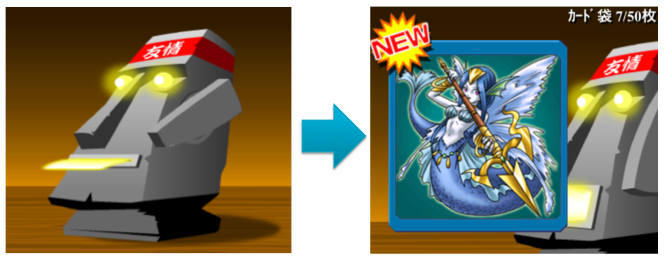One of the main reasons DeNA, GREE and (some of) the 400+ third-party social game makers in Japan are raking in as much money as they do is “gacha”, a special element found in almost every social game in this country.
I created a quick guide to explain the gacha phenomenon:
I) BACKGROUND
Wikipedia explains gacha in the real world like this (shortened):
Gashapon is a Bandai brand trademark widely used throughout the world for their capsule toys. It is also referred to as gachapon. Both gashapon and gachapon are Japanese onomatopoeia, made up of two sounds: “gasha” or “gacha” for the turning of a crank on a toy vending machine, and “pon” for the sound of the toy capsule dropping into the receptacle.
It is used to describe both the machines themselves, and any toy obtained from them.
Gashapon machines are similar to the coin-operated toy vending machines seen outside of grocery stores and other retailers in other countries.
II) GACHA MECHANISM IN SOCIAL GAMES
A while ago, Japanese social game providers started turning those little toy vending machines found in real life into a social game mechanic – today, virtual gacha are an integral part of nearly every title on Mobage, GREE, and Mixi.
Take Konami’s Dragon Collection, for example. In this game, the gacha machine is visualized as a statue, and the virtual item to be obtained is a card (Dragon Collection is a social card battle game):
Some companies started implementing virtual gacha machines into existing games, after realizing how popular the concept is.
When Popcap localized Bejeweled Blitz for the Japanese market, they implemented gacha, too: in a puzzle game of all genres.
III) Pricing and criticism
Pricing varies depending on the title: some games charge 100 Yen per turn, others 300 yen. The more expensive gacha contain particularly rare cards, but the element of luck is always there.
A lot of makers offer playing gacha once per day for free in order to a) get users “addicted” and b) to boost retention/the number of log-ins. Makers also offer discounts (for example during a special sales campaign), or limited-edition items (for example during seasonal events like Christmas or Halloween).
And gacha work well – extremely well: from some makers, I am hearing that up to 50% of their overall sales come from these machines. People just can’t stop paying money (in the form of paid virtual coins or tokens) to be able to go for another round.
Games can be designed in a way that players can receive certain rare items only through playing gacha. This is one of the reasons why the mechanic is subject to some (still relatively mild) criticism in Japan, where it is likened with gambling by some voices.
There are critical journalists, for example, demanding the social gaming industry in Japan as a whole to be regulated – gacha are often cited as one of the main arguments.
IV) Video
Here is a video I took that shows the gacha mechanism in action (direct link to video)

